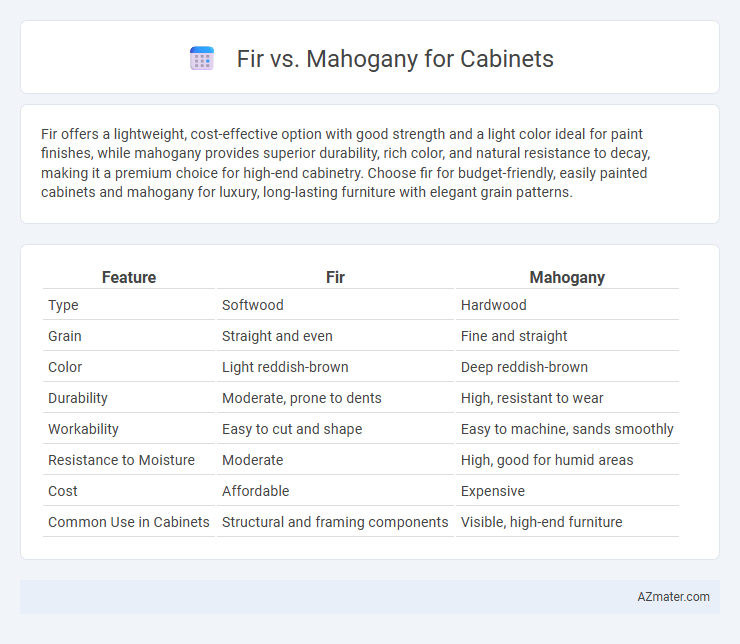Fir offers a lightweight, cost-effective option with good strength and a light color ideal for paint finishes, while mahogany provides superior durability, rich color, and natural resistance to decay, making it a premium choice for high-end cabinetry. Choose fir for budget-friendly, easily painted cabinets and mahogany for luxury, long-lasting furniture with elegant grain patterns.
Table of Comparison
| Feature | Fir | Mahogany |
|---|---|---|
| Type | Softwood | Hardwood |
| Grain | Straight and even | Fine and straight |
| Color | Light reddish-brown | Deep reddish-brown |
| Durability | Moderate, prone to dents | High, resistant to wear |
| Workability | Easy to cut and shape | Easy to machine, sands smoothly |
| Resistance to Moisture | Moderate | High, good for humid areas |
| Cost | Affordable | Expensive |
| Common Use in Cabinets | Structural and framing components | Visible, high-end furniture |
Introduction: Fir vs Mahogany for Cabinet Making
Fir offers a lightweight, cost-effective option with a straight grain and good workability, ideal for cabinets requiring ease of customization and a natural, pale finish. Mahogany provides superior durability, rich reddish-brown hues, and a smooth texture, making it a premium choice for luxury cabinetry that demands elegance and long-lasting quality. Both woods differ significantly in hardness, grain pattern, and finishing potential, influencing their suitability depending on aesthetic preferences and functional requirements.
Wood Characteristics: Fir and Mahogany Compared
Fir wood features a straight grain with a pale yellow to reddish-brown hue, offering moderate hardness and excellent stability, making it resistant to warping in cabinet construction. Mahogany displays a rich reddish-brown color with a fine, uniform grain pattern, prized for its durability, smooth finish, and natural resistance to decay and insect damage. Both woods provide distinct aesthetics and performance, with fir being lightweight and cost-effective while mahogany offers superior strength and a luxurious appearance for high-end cabinetry.
Durability and Strength: Which Wood Lasts Longer?
Mahogany is known for its superior durability and strength compared to fir, making it a longer-lasting choice for cabinets. With a density of around 0.60 to 0.85 g/cm3, mahogany resists warping and dents better than fir, which has a lower density of approximately 0.35 to 0.45 g/cm3. Cabinets made from mahogany withstand daily wear and environmental changes more effectively, enhancing their longevity and structural integrity.
Appearance and Grain: Visual Differences
Fir cabinets exhibit a lighter and more uniform appearance with straight, prominent grain patterns that create a clean, rustic look. Mahogany cabinets display a rich, deep reddish-brown color featuring fine, interlocking grain that often includes a subtle sheen, contributing to an elegant and luxurious aesthetic. The distinct grain complexity and color warmth of mahogany make it a preferred choice for high-end cabinetry, while fir offers a more casual and natural wood texture.
Ease of Workability: Machining and Finishing
Fir offers superior ease of workability due to its straight grain and softer texture, allowing for smoother machining and less wear on cutting tools. Mahogany, while denser and harder, provides a fine, even grain that responds well to finishing, delivering a rich, polished appearance but may require more careful handling during machining. Both woods finish beautifully, but fir's lighter density reduces tool strain, making it preferable for intricate cabinetry work.
Cost Comparison: Fir vs Mahogany Cabinets
Fir cabinets offer a cost-effective alternative to mahogany, with prices typically ranging between $30 to $50 per board foot compared to mahogany's $60 to $100 per board foot. The affordability of fir makes it a popular choice for budget-conscious projects without compromising on durability. Mahogany's higher price reflects its superior grain quality, color richness, and natural resistance to decay, which may justify the investment for premium cabinetry.
Sustainability and Environmental Impact
Fir wood, often sourced from well-managed forests, offers a renewable option with faster growth rates and lower carbon footprints compared to mahogany. Mahogany, prized for its durability and rich color, is frequently harvested from tropical rainforests, raising concerns about deforestation and biodiversity loss. Choosing sustainably certified fir cabinets supports environmental conservation and reduces ecological impact in cabinetry projects.
Best Uses: Where Each Wood Excels in Cabinetry
Fir wood excels in cabinetry for rustic and contemporary designs due to its straight grain and warm reddish-brown hue, making it ideal for kitchen cabinets and furniture that require durability and a natural aesthetic. Mahogany is preferred for high-end cabinetry because of its rich, deep color and fine grain, providing exceptional strength and resistance to swelling, which makes it perfect for custom cabinetry, formal furniture, and decorative millwork. Both woods offer unique benefits: fir is more affordable and easier to work with, while mahogany delivers superior elegance and long-term durability in luxury cabinetry projects.
Maintenance and Longevity
Fir cabinets require regular maintenance to prevent warping and moisture damage due to their softer wood structure, which can be less durable over time. Mahogany offers superior longevity with its dense, hardwood composition that resists scratches, decay, and environmental wear, reducing the need for frequent upkeep. Choosing mahogany ensures a longer-lasting, low-maintenance cabinet ideal for high-use areas.
Fir vs Mahogany: Which is Best for Your Cabinets?
Fir offers a lightweight, durable option with a pale, uniform grain that absorbs stains evenly, making it ideal for custom cabinet finishes. Mahogany, prized for its rich, reddish-brown color and natural resistance to moisture and decay, provides a luxurious, high-end look with superior durability in humid environments. Choosing between fir and mahogany depends on budget constraints, aesthetic preferences, and the cabinets' exposure to moisture or wear.

Infographic: Fir vs Mahogany for Cabinet
 azmater.com
azmater.com